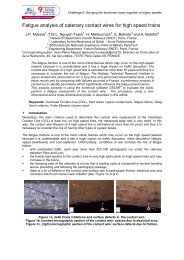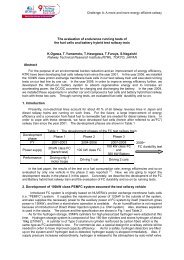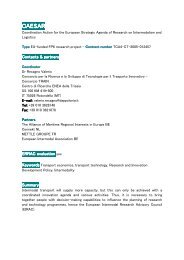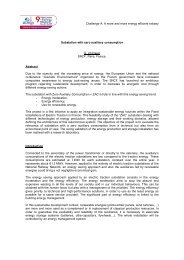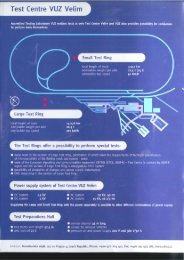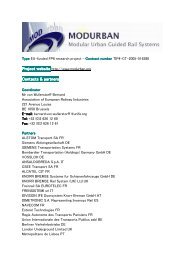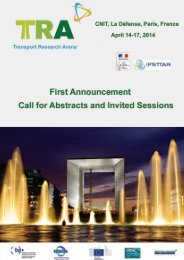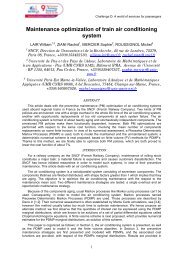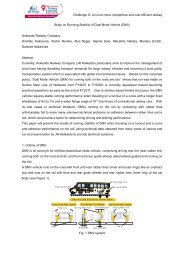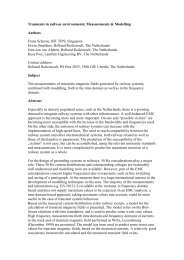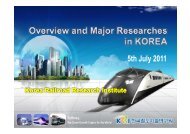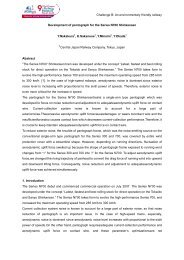Track Buckling Hazard Detection and Rail Stress Management
Track Buckling Hazard Detection and Rail Stress Management
Track Buckling Hazard Detection and Rail Stress Management
You also want an ePaper? Increase the reach of your titles
YUMPU automatically turns print PDFs into web optimized ePapers that Google loves.
Challenge C: Increasing Freight capacity <strong>and</strong> services<br />
other maintenance work undertaken during cold weather <strong>and</strong> from excessive rail movement. A key<br />
impediment to knowing these low <strong>and</strong> potentially dangerous RNTs is a lack of adequate measurement<br />
capability which has eluded researchers for the past three decades. There have been several<br />
measurement concepts/techniques proposed <strong>and</strong> evaluated over the years with mixed results. These<br />
included techniques based on various physics concepts as illustrated in Figure 1.<br />
RNT Measurement Concepts/Issues<br />
Concepts Researched<br />
• Mechanical/electrical<br />
resistance strain gage<br />
• <strong>Rail</strong> uplift<br />
• <strong>Rail</strong> vibration<br />
• Vibrating wire/filament<br />
• Ultrasonic wave<br />
• Acoustic wave<br />
• Electromagnetic/acoustic<br />
wave (EMAT)<br />
• Magnetic permeability:<br />
(Barkhausen noise)<br />
(Magnetostriction)<br />
• X-ray diffraction<br />
Measurement Difficulties<br />
• Accuracy Issues:<br />
sensitivity to rail<br />
microstructure, residual<br />
stresses, track parameters;<br />
hard to get force/RNT from<br />
stress; “zeroes” required<br />
• Don’t provide real-time,<br />
continuous data output<br />
• Not nondestructive <strong>and</strong><br />
not easily deployable<br />
• No direct applicability<br />
to railroad maintenance<br />
<strong>and</strong> safety practices<br />
Figure 1 – Summary of RNT Measurement Concepts<br />
The key compromising aspects being (1) measurement accuracy, (2) ease of deployment, (3) providing<br />
continuous data on a real time basis, <strong>and</strong> (4) having direct applicability to railroad maintenance <strong>and</strong><br />
safety. Although several concepts partially fulfill these needs, the US Salient System’s <strong>Rail</strong> <strong>Stress</strong> Monitor<br />
(RSM) <strong>and</strong> its supportive <strong>Stress</strong>Net TM data base system have evolved to be the most responsive to the<br />
above needs. The RSM <strong>and</strong> its <strong>Stress</strong>Net TM technology have been developed <strong>and</strong> tested over twenty-five<br />
years of R&D, <strong>and</strong> have been recently exp<strong>and</strong>ed to support specific industry needs to not only measure<br />
RNT but interpret it for practical application to enhance overall CWR safety <strong>and</strong> performance. More<br />
specifically the RSM <strong>and</strong> <strong>Stress</strong>Net TM technology:<br />
<br />
<br />
<br />
<br />
<br />
Measures longitudinal force <strong>and</strong> RNT<br />
Detects rail breaks <strong>and</strong> track buckles<br />
Alerts on potential buckling hazards<br />
Enables more effective rail break/defect repairs<br />
Monitors rail joint condition<br />
In this paper several of these applications will be discussed with a particular emphasis on track buckling<br />
prevention through potential hazard identification diagnostics in terms of a “green”, “yellow”, “orange” or<br />
“red” buckling hazard warning.<br />
2.0 The RSM-<strong>Stress</strong>Net TM System (The RSM Technology)<br />
The rail-mounted hardware represents continuing evolving technology developments starting with a<br />
stress measurement circuit first developed at Battelle Columbus Laboratories in the early eighties [1, 2,<br />
2



